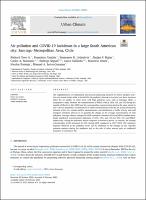Air pollution and COVID-19 lockdown in a large South American city: Santiago Metropolitan Area, Chile
Metadata
Show full item recordAuthor(s)
Date
2021-02Subject
Calidad del Aire - Contaminantes Atmosféricos - Calidad Ambiental - Vigilancia de Contaminantes - Air Quality - COVID-19 - South AmericaCollections
- Artículo científico [171]
Related Resource(s)
https://www.sciencedirect.com/science/article/pii/S221209552100033XAbstract
The implementation of confinement and physical distancing measures to restrict people's activities and transit in the midst of the COVID-19 pandemic allowed us to study how these measures affect the air quality in urban areas with high pollution rates, such as Santiago, Chile. A comparative study between the concentrations of PM10, PM2.5, NOx, CO, and O3 during the months of March to May 2020 and the corresponding concentrations during the same period in 2017–2019 is presented. A combination of surface measurements from the air quality monitoring network of the city, remote satellite measurements, and simulations of traffic activity and road transport emissions allowed us to quantify the change in the average concentrations of each pollutant. Average relative changes of traffic emissions (between 61% and 68%) implied statistically significant concentrations reductions of 54%, 13%, and 11% for NOx, CO, and PM2.5, respectively, during the pandemic period compared to historical period. In contrast, the average concentration of O3 increased by 63% during 2020 compared to 2017–2019. The nonlinear response observed in the pollution levels can be attributed to the changes in the vehicular emission patterns during the pandemic and to the role of other sources such as residential emissions or secondary PM.
The following license files are associated with this item:








